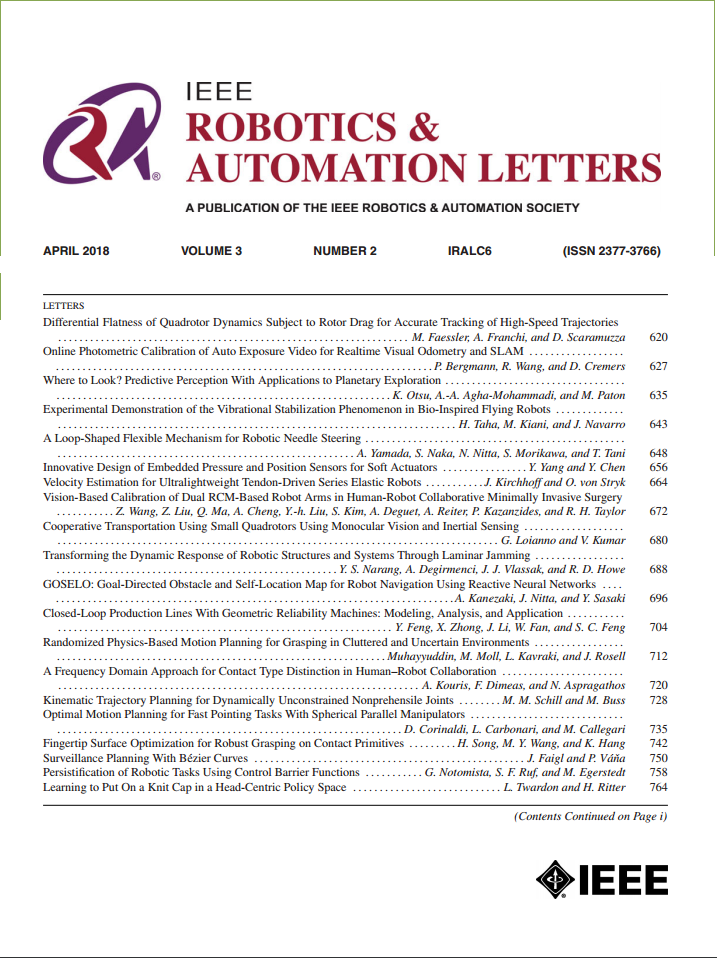具有可重构基线的尖端柔性内窥镜增强3D感知
IF 5.3
2区 计算机科学
Q2 ROBOTICS
引用次数: 0
摘要
立体内窥镜广泛应用于微创心脏手术,通过小切口提供胸腔的三维信息。然而,目前的高精度三维感知方法往往降低了内窥镜的灵活性,限制了其视野。本研究提出了一种专为心脏手术设计的可重构基线尖端柔性内窥镜,提供增强的3D感知能力。采用反对称约束结构和深度驱动基线控制方法实现高精度三维感知。值得注意的是,它可以适应多自由度的尖端柔性结构和受限的手术环境,而不会增加算法和传感器的复杂性,从而为外科医生提供更大的操作空间。在基于幻象的实验中,与对照组的0.58 mm相比,实验组在60-110 mm处的RMSE较低,为0.41 mm。在离体试验中也观察到类似的结果,rmse分别为0.40 mm和0.57 mm,增强了其临床潜力。外部参数保持在可接受范围内,主要误差因子$\Delta \theta$控制在RMSE为0.01428 $^{\circ }$。这些结果验证了所提出的方法,并为微创手术中的高精度三维感知提供了新的途径。本文章由计算机程序翻译,如有差异,请以英文原文为准。
A Tip-Flexible Endoscope With Reconfigurable Baseline for Enhanced 3D Perception
Stereoscopic endoscopes are widely used in minimally invasive cardiac surgery, providing 3D information of the thoracic cavity through small incisions. However, current high-precision 3D perception methods often reduce the flexibility of the endoscope, limiting its field of view. This study proposes a reconfigurable-baseline tip-flexible endoscope specifically designed for cardiac surgery, offering enhanced 3D perception capability. An anti-symmetric constraint architecture and a depth-driven baseline control method are adopted for high-precision 3D perception. Notably, it can adapt to multi-degree-of-freedom tip-flexible structures and constrained surgical environments without increasing the complexity of algorithms or sensors, thereby providing surgeons with greater operational space. In phantom-based experiments, the experimental group achieved a lower RMSE of 0.41 mm at 60–110 mm, compared to 0.58 mm in the control group. Similar results were observed in ex vivo tests, with RMSEs of 0.40 mm and 0.57 mm, respectively, reinforcing its clinical potential. External parameters remained within acceptable ranges, with the dominant error factor, $\Delta \theta$ $^{\circ }$
求助全文
通过发布文献求助,成功后即可免费获取论文全文。
去求助
来源期刊

IEEE Robotics and Automation Letters
Computer Science-Computer Science Applications
CiteScore
9.60
自引率
15.40%
发文量
1428
期刊介绍:
The scope of this journal is to publish peer-reviewed articles that provide a timely and concise account of innovative research ideas and application results, reporting significant theoretical findings and application case studies in areas of robotics and automation.
 求助内容:
求助内容: 应助结果提醒方式:
应助结果提醒方式:


